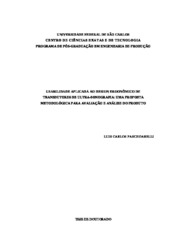Usabilidade aplicada ao design ergonômico de transdutores de ultra-sonografia: uma proposta metodológica para avaliação e análise do produto.
Abstract
The usability is one of the main aspects of the performance and quality of the interface hand/instruments whose applicability is based on methodologies of ergonomic design. In spite of the technological evolution, some hand instruments still do not attend the criteria of usability and may generate ergonomic problems in users. An example of it is the transductor employed in breast ultrasonography (US) occupational activities, which requires large biomechanical efforts. This study aimed at proposing a method of assessment and analysis based on subjective and physiological records during the application of criteria of usability in the ergonomic redesign of the transductor for US breast examinations. In order to conductthe physiological records, a Biometrics electrogoniometer was used for the analysis of wrist movements, and FSRs sensors were used for the analysis of palmar pressure. As for the subjective assesments, graphic scales of perception were applied. The collection of data occurred in experimental phases: First Experimentation assessment of wrist postures during the simulation of activity with two commercial types of transductors (n= 18); Ergonomic design application of the criteria of usability in the redesign and prepraration of the mock-up; Second Experimentation assessment of the postures and points of palmar pressure during the simulation of activity with the new mock-up and the commercial transductors (n = 10); Ergonomic design/project revision revision of the criteria of usability and development of two new mock-ups; Third experimentation assessment of the postures and points of palmar pressure during the simulation of activity with the new mock-ups and the commercial transductors (n = 10); Fourth experimentation subjective assessment of all the transductors (n = 11). The results of the first experimentation indicated high median and maximal amplitudes. The ergonomic design turned up into mock-up 01. The results of the second experimentation indicated that mock-up 01 did not present improvements in terms of wrist posture, but rather a better distribution of pressure in the palmar region. The ergonomic design/project revision turned up into two new mock-ups, 02 and 03, which presented (in the results of the third experimentation) a lower amplitude for movements and a better distribution of the percentage of time in the different pre-established ranges of amplitude, as well as in the pressure of the palmar region, mainly when mock-up 02 is concerned. Statistically meaningful differences (p < 0,05) were found only in the third experimentation, indicating that mock-ups 02 and 03 presented better performance. The results of the fourth experimentation indicated similar results from the physiological assessment, corroborating its results. Such procedures characterized a consistent alternative to the traditional methods for assessing and analyzing hand instruments in ergonomic design.
